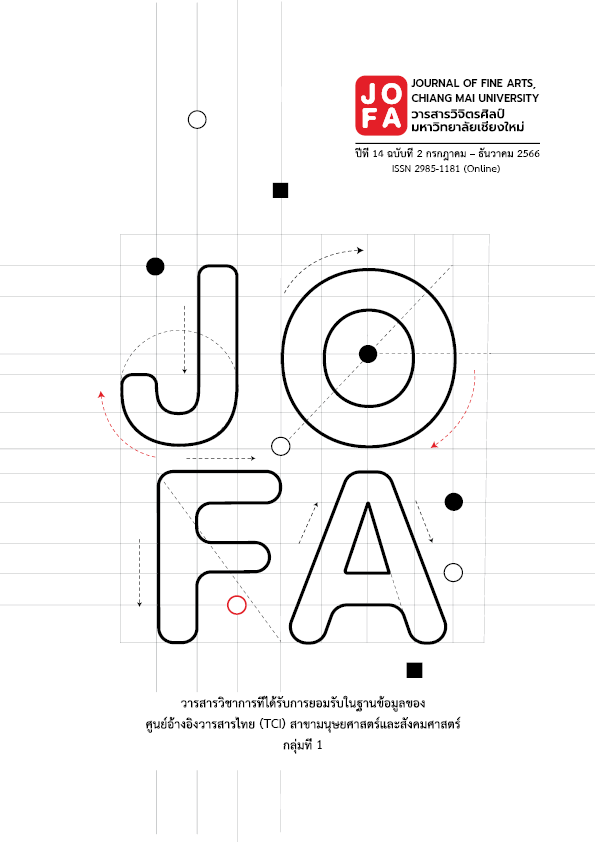A Study of Techniques for Ceating Panoramic Photograph of Street Line on Thapae Road
Main Article Content
Abstract
This research article presents result and the discussion of the result from research which studied the guidelines and the technique for creating panoramic image of long stretching city street line by stitching photographs which are taken with Multi-Perspective photography technique. The study began with literature review on method and technique from related document and creative works then use the acquired knowledge to create panoramic images of buildings and architectures on Thapae Road, Chiang Mai, which is one of the historically important areas full of traces of development into modern era of the society and the city of Chiang Mai.
The outcomes of this study consisted of panoramic cityscape of buildings on both sides of Thapae Road presented in a form of two completed panoramic images which are shown in the research result section of the article, as well as an example of application of the images to present them the form of an accordion photobook, and techniques and method for creating such images. The mentioned method begins with photographing the intended area that would be turned into panoramic image, where the creator should study the lighting condition at different times in the area as well as the suitable weather condition to reduce the differences between each photograph before photographing the area with Multi-Perspective method, which is photographing the façade of each building and move the camera along the buildings on the street instead of panning the camera from a single point of view as in normal panoramic photography, and shoot each photograph with sufficient overlapping area for later stitching. The photographs are then edited and stitched together into panoramic image with a computer program. It was found in the last step that the photographs are unable to be stitched automatically using computer program command due to various image distortion problems that were caused by multi-perspective photography technique; this forced the researcher to stitch the photographs by himself, which required a long period of time. However, these image distortion problems present opportunities for further research in this technique of panoramic image creation. The details will be discussed in the result discussion section within this article.
Article Details

This work is licensed under a Creative Commons Attribution-NonCommercial-NoDerivatives 4.0 International License.
References
Chui, K. (2016, May 13). Ginza Kaiwai/ Ginza Haccho in 1954 By Yoshikazu Suzuki & Kimura Shohachi. Medium. https://medium.com/@karenchui/ginza-kaiwai-ginza-haccho-540a763dfb35
Davenport, J. (n.d.). The dPS Ultimate Guide to Photography for Beginners. Digital Photography School. https://digital-photography-school.com/ultimate-guide-photography-beginners
Dietrich, J. (2015, April 23). Zur Technik des linearen Panoramas. Leipziger Ring Panorama. https://leipzigerring.de/technik-linear-panorama-montage
Gray, E. (2019, April 29). What is Focal Length in Photography. Photography Life. https://photographylife.com/what-is-focal-length-in-photography
Guy-Bernard (pseud.). (2011, June 7). YOSHIKAZU SUZUKI and SHOHACHI KIMURA Ginza Kaiwai. Ginza Haccho. Tokyo: Toho-shobo, 1954. never trust a man who can dance. http://aaaaaaaaaaaaaaaaaaaargh.blogspot.com/2011/06/yoshikazu-suzuki-and-shohachi-kimura.html
Harmsen, N. (2020, May 16). Beginners Guide to Parallax and How to Avoid It When Shooting Panoramas. Fstoppers. https://fstoppers.com/education/beginners-guide-parallax-and-how-avoid-it-when-shooting-panoramas-485141
Harry Ransom Center. (n.d.). The Niepce Heliograph. Harry Ransom Center. https://www.hrc.utexas.edu/niepce-heliograph/
Iber Libro. (1954). GINZA KAIWAI/GINZA HACCHO: THE 1954 FIRST EDITION – Rare Fine Copy of The First Edition/First Printing: With Hand-Made Black Cloth Slipcase. Japan: Toho-Shuppan Publishing.
Lambrechts, G. (2020, February 11). What you want to know about architectural photography.The Landscape Photo Guy. https://thelandscapephotoguy.com/architectural-photography/#:~:text=Architectural%20photo%20graphy%20and%20cityscape%20ph otography,on%20isolated%20buildings%20or%20constructions
Library of Congress. (n.d.). A Brief History of Panoramic Photography. Library of Congress. https://www.loc.gov/collections/panoramic-photographs/articles-and-essays/a-brief-history-of-panoramic-photography/
Mansurov, N. (2021, August 23). Panoramic Photography Tutorial. Photography life. https://photographylife.com/landscapes/panoramic-photography-howto
Marien, M. W. (2012). 100 Ideas that changed photography. London: Lawrence King Publishing.
Newhall, B. (2021, November 15). History of Photography. Britannica. https://www.britannica.com/technology/photography
Panorama Streetline. (n.d.). Lineares Streetline Panorama vs. Klassisches 360 Panorama. Panorama Streetline. https://panoramastreetline.de/news/linear-streetline-panorama-vs-classic-360-panorama
Pichler, M. (2018). GINZA HACCHO/EVERY BUILDING ON THE GINZA STRIP. Kodoji press. https://www.shashasha.co/en/book/ginza-haccho-every-building-on-the-ginza-strip
Porananond, A. (2017). Prawattisāt Kān Thāi Phāp : Rư̄angrāo Khō̜ng Kān Thāi Phāp Tangtǣ Yuk Kō̜n Kān Thāi Phāp Thưng Kān Thāi Phāp Rūamsamai [History of Photography: Stories of Photography from Pre-Photography Era until Contemporary Photography Era]. Chiang Mai: Photographic Art Department, Faculty of Fine Arts, Chiang Mai University.
Suwatcharapinun, S. (2016). Yō̜n ʻān Sathāpattayakam Tưkthǣo Nai Thanon Thā Phǣ : Sēnthāng Khō̜ng Khwām Thansamai Mư̄ang Chīang Mai [Re-reading Architecture of Row-Houses in Thapae Road : a Passage of Chiang Mai’s Modernization]. NAJUA: History of Architecture and Thai Architecture, 13, 230-259.
Uesaki, S. and Stojkovic, J. (2018). “The Grain of Ephemera/Event: Thinking Digital Archive through Photography” In Photography Reframed: New Visions in Contemporary Photographic Culture. (Burbridge, B. and Pollen, A., Eds.). London/New York: I.B. Tauris.


